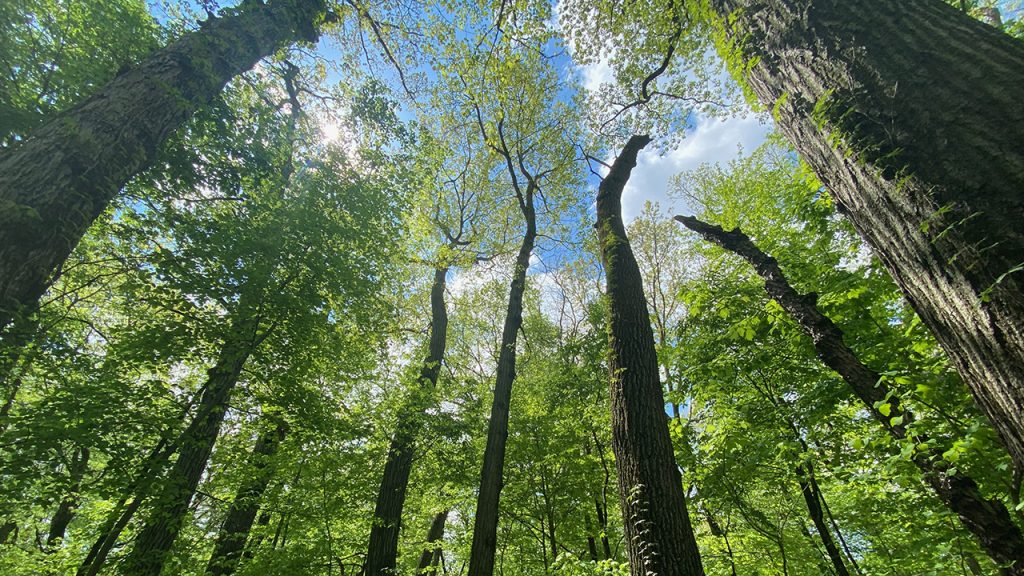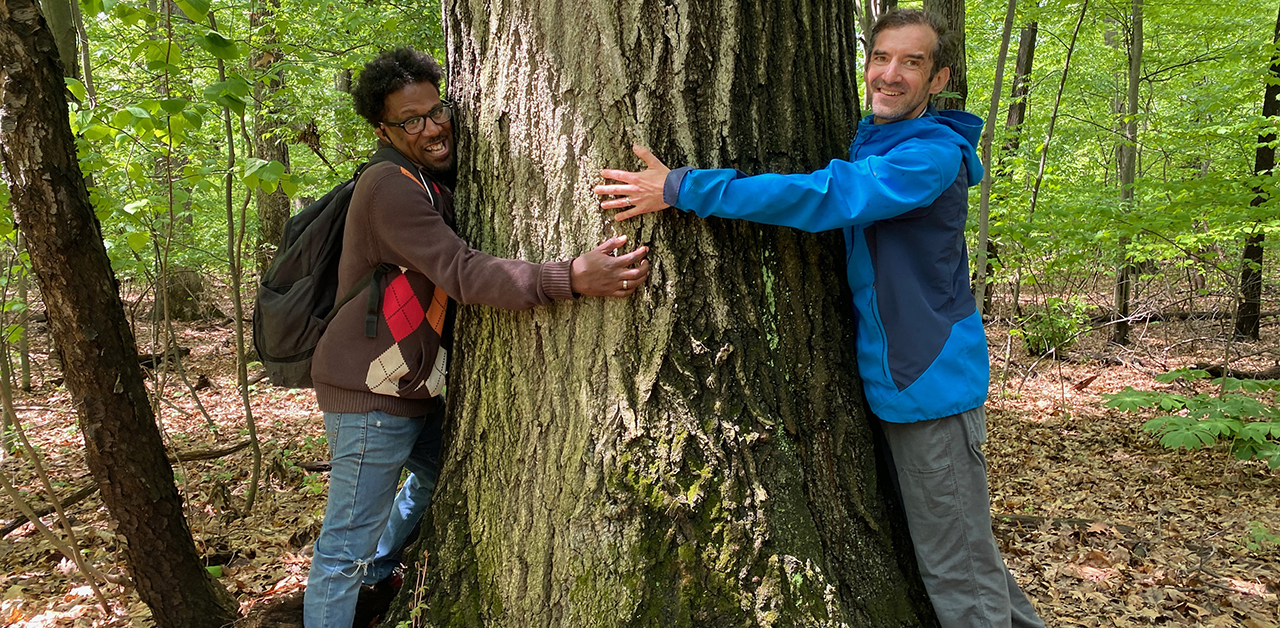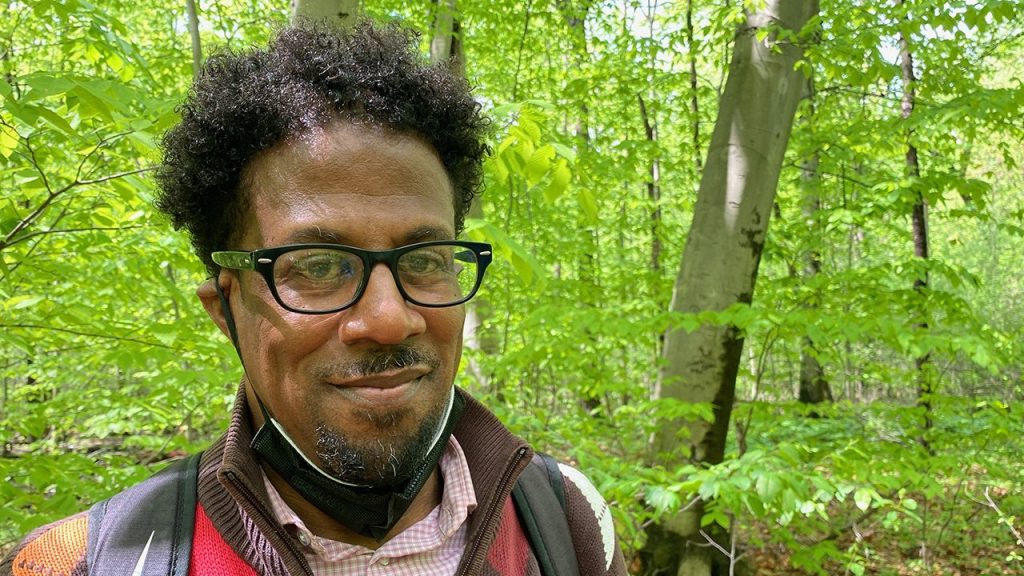CuriosiD: Are the woods in Palmer Park a virgin forest?
Nina Ignaczak July 14, 2022
A view of the tree canopy in Palmer Park's Witherell Woods, the largest old-growth forest in the Tri-County area.
In this episode of CuriosiD, listener Douglas Cook asks …
Is Palmer Park a virgin forest, unaltered by humans?
The Short Answer
The short answer to Douglas’ question is “no, but it’s complicated.” On the one hand, we can’t call the woods in Palmer Park a virgin forest because they have been changed by people; they have been selectively logged, they have trails and also they have been impacted by invasive species – plants and shrubs from Europe and Asia that threaten to change the forests’ species composition. The other reason we don’t want to call the wooded area there a virgin forest is that a growing number of forest ecologists are rejecting the term. The woods there, however, are still noteworthy and can be considered a remnant forest.
Why are there so many big trees in these woods at Palmer Park?
The forest in Palmer Park is called Witherell Woods after U.S. Sen. Thomas Witherell Palmer. He donated 140 acres to the city for a park in 1893 with the condition that the forest would be preserved. Sen. Palmer had inherited 80 acres from his grandfather, Michigan politician and judge James Witherell. The latter was appointed by President Thomas Jefferson as one of the judges of the Supreme Court for the Territory of Michigan in 1808.
The woods were never cleared for development, meaning this tract of land has remained forested since European settlement. Several unique forest ecosystems comprise it, owing to a diverse topography influenced by glaciers. A sandy beach ridge formed at the end of the last ice age marks the shoreline of ancient Lake Maumee, an ancestor of Lake Erie that formed about 14,000 years ago when mile-thick glaciers began to melt away. This diverse topography is one reason so many different native species are here. A 2004 species survey found an array of three distinct forest ecosystem types and more than 100 native species in Witherell Woods, including relatively uncommon species like black gum, sassafrass and pin oak.
How have the woods at Palmer Park changed?
There are still some very big trees in Witherell Woods, particularly large oak trees like this one that Dan Scarsilla and Douglas Cook can’t get their arms around.

The woods have been impacted by two main forces over the past 200 years: selective logging and invasive species. Selective logging means the removal of just one or two tree specimens from a woodland without clear-cutting an entire woodland. It is known to be one of the human impacts on Great Lakes forests in the 19th and early 20th centuries.
Scarsilla, a co-founder of People for Palmer Park, told us that he was aware of people logging in the park as recently as the past decade and had seen articles about illegal tree removal. Also, the 2004 species survey of the forest suggested that a preponderance of beech in the beech-sugar maple portion of the woods could “be the result of heavy selective cutting of sugar maple.”
More recently, invasive species have impacted the woodlands in Palmer Park. Invasive shrubs and plants like garlic mustard, honeysuckle and buckthorn were transported by humans from Europe and Asia, mainly during the 20th century. These species compete with and crowd out native species, causing the forest to change and decline in quality. Friends of Palmer Park has been actively managing garlic mustard in recent years, holding events where volunteers can help pull out the plant to prevent it from out-competing the native ground flora.
Is Witherell Woods a virgin forest?
As discussed, the forest ecosystem at Palmer Park is relatively intact, meaning there are many examples of native trees, shrubs and other plants. It was never cleared for agriculture or development and there has been a forest since before European settlement. So can we call it a virgin forest, often defined as a woodland untouched by humans? Not really.
One the one hand, the forest in Palmer Park has been changed by people; it has been selectively logged, has trails and also has been impacted by invasive species – plants and shrubs from Europe and Asia that threaten to change the forests’ species composition.
The other reason we don’t want to call it a virgin forest is that a growing number of forest ecologists are rejecting the term. “There’s no such thing as a virgin forest or something that’s been untouched by by humans,” says Richard Kobe, the chair of the Department of Forestry at Michigan State University. “Just about every area of the Earth has had some kind of human settlement, even in the Amazon.”
Indigenous peoples built elevated passageways through the Amazon Forest to connect their villages, Kobe says. And here in Michigan, Native peoples would often go into woods like the ones in Palmer Park to tap sugar maple trees.
While we can’t say the forest in Palmer Park is virgin, it is noteworthy because it’s a remnant woodland, according to David Yocca, a landscape architect who’s working on a restoration project there in conjunction with People for Palmer Park, the City of Detroit and a team of ecologists and other landscape architects.
“That area of the park has never been altered for development or plowed or significantly modified,” says Yocca.
Restoring the Park
This fall, a team of city contractors and volunteers will start removing invasive species. Their first goal is to clear out the forest floor of nonnative shrubs and invasive woody undergrowth like buckthorn and honeysuckle to open up the forest floor to sunlight and allow native species to grow. After hand-removing invasive plants, they’ll start doing prescribed burns – a kind of forest fire set on purpose under controlled conditions – to clear out unwanted vegetation further.
To get involved in these activities, contact Farhat Chaudhry, Project Manager / Designer at 313-224-1100 chaudhryf@detroitmi.gov.
Meet the listener
Douglas Cook is a Detroit native who grew up near Witherell Woods and now lives on the city’s east side.

Photos by Nina Ignaczak
Talk to us: What are your reactions to this episode? Whatever you want to tell us about this episode, we want to hear it!
Have you been to the woods in Palmer Park? If so, what did you think of them? Are there other trails that are your favorite in the Detroit area? We want to hear from you. Call 313-403-5747 and leave us a voice message or record a voice memo on your phone and email it to CuriosiD@wdet.org. We might include your comments in a future CuriosiD episode!
Trusted, accurate, up-to-date.
WDET strives to make our journalism accessible to everyone. As a public media institution, we maintain our journalistic integrity through independent support from readers like you. If you value WDET as your source of news, music and conversation, please make a gift today.
Author
-
 Nina Ignaczak is an award-winning journalist and documentary filmmaker in Metro Detroit. She is the founder and executive editor of Planet Detroit, a digital media startup that tells Detroit’s environmental stories while building a community of engaged readers who are informed and empowered to act personally and publicly. She is also a former digital editor at WDET.
Nina Ignaczak is an award-winning journalist and documentary filmmaker in Metro Detroit. She is the founder and executive editor of Planet Detroit, a digital media startup that tells Detroit’s environmental stories while building a community of engaged readers who are informed and empowered to act personally and publicly. She is also a former digital editor at WDET.
